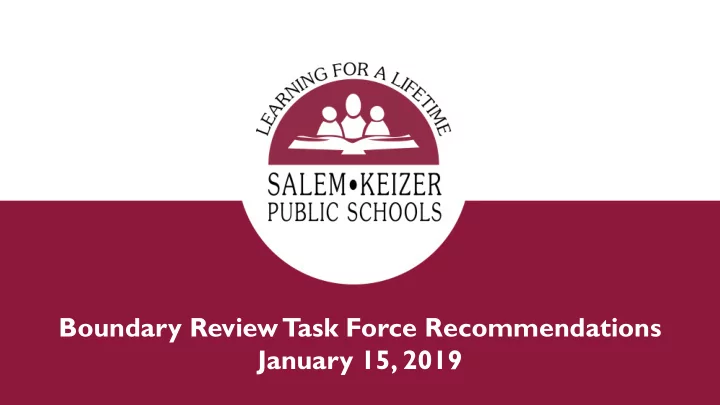

Boundary Review Task Force Recommendations January 15, 2019
Overview and Outcomes q Outcomes: § January 15 – Clarifying Questions § January 22 – Work Session w/Board Engagement and First Reading § February 12 – Board Decision § September 2019 Implementation q 2018 General Obligation Bond q Boundary Review Process q Boundary Review Task Force Recommendations
2018 Bond Program q Program Description Over 70% to support current and future enrollment § q Planning Assumptions PSU student projections § Educational Specifications § q Capacity Analysis Number of classrooms required to meet projected § enrollment growth q Connection to Boundary Review Process
Boundary Review Process q Superintendent’s Charge q Task Force Organization, Process and Timeline
Superintendent’s Charge q Using the district’s boundary adjustment guiding principles and equity focus , review the springboard proposal to develop a consensus set of recommendations that: Creates a balance between high school attendance feeder systems § Aligns future student populations with future school capacities § Identifies implications for the 2018 Bond Program § q Intentionally engage community members of underserved, diverse or marginalized individuals and groups q Presentation at January 15, 2019 Board meeting
Guiding Principles q Allow adequate room for required programs and anticipated growth within each school’s capacity and throughout the district q Ensure access to equitable educational opportunities q Ensure safety to and from school q Provide continuity in school assignments for students, families, and schools q Ensure affected/impacted community members are involved in the process and represent ethnic and socioeconomic diversity q Consider the impact to established neighborhoods
Equity Focus q Process and Outcome Intentionally ask ourselves throughout the work of the task force whether § we are making decisions in the best interest of underserved, diverse or marginalized students and families: Do we fully understand the impacts of the recommendations? • How do the recommendations create more equitable outcomes for • our students? Have we created unintended negative consequences and if so, how can • they be mitigated?
Consensus q Members collaboratively develop and support recommendations that are in the best long term interest of the students, families and the broader community q Not 100% agreement q Allows for diverse perspectives q Each individual has the opportunity to voice their perspectives, thoughts and values in the development of recommendations that can be supported, even if the individual may have made a different decision on their own
Task Force Organization q Co-Chairs provide leadership and planning with staff q Task Force Members provide school, community and equity perspective q Staff/FLO team provide facilitation, guidance and resources
Process and Timeline January – August 2018 Internal Staff Team and FLO Analytics q Springboard Proposal q September – December 2018 Task Force Work Groups q Community Engagement q January 2019 Co-Chairs Present to Superintendent q February 2019 q Board Approval for Fall 2019 Implementation
Task Force Recommendations q Community Input q Balancing High School Feeder Systems q Aligning to five and ten year capacities
Community Input q Community Survey and Engagement Events Overcrowding/class size § Maintaining neighborhood schools § Transportation § Fear of change and disruption § Program support § Equity v. Equality §
Existing School Feeder System North Salem McNary West Salem Claggett Creek & Houck & Parrish* Whiteaker Straub & Walker Clear Lake, Cummings, Gubser, Keizer, Auburn, Englewood, Eyre, Four Corners, Grant, Brush College, Chapman Hill, Harritt, Forest Ridge, Kennedy*, & Weddle Highland, & Miller Kalapuya*, & Myers McKay Sprague South Salem Crossler & Stephens, Parrish* Judson* & Waldo Judson*, Leslie, & Parrish* Battle Creek*, Liberty, Salem Heights, Schirle, Sumpter*, & Wright *These ES or MS attendance areas assign students to two Bush, Candalaria, Hoover*, Lee, McKinley, Cesar Chavez*, Hallman, Hammond, Hayesville, Hoover*, Lamb, different middle or high schools by residence address. Morningside, Pringle, & Richmond Scott*, Swegle, Washington, & Yoshikai
Task Force Recommendations q Boundary Adjustments https://salkeiz.k12.or.us/ §
Task Force Recommendations q Connection to Bond Projects at Kennedy ES and Miller ES § q Review and Adjust Processes Continuity Exemption § In-District Transfer § q Conduct Final Staff Review Transportation § Additional Investments §
Salem-Keizer Public Schools Our Vision: All students graduate and are prepared for a successful life
Recommend
More recommend